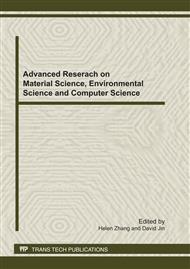[1]
Dale R. Van Stempvoort, Kelly Millar, and John R. Lawrence: Accumulation of short-chain fatty acids in an aquitard linked to anaerobic biodegradation of petroleum hydrocarbons, Applied Geochemistry. J. vol. 24, p.77–85, (2009).
DOI: 10.1016/j.apgeochem.2008.11.004
Google Scholar
[2]
Zhang Liang, Ma Zhenmin, and Yu Weiwei: Mechanism of oil Pollution in Groundwater System of a Refinery, JOURNAL OF UNIVERSITY OF JINAN ( Sci & Tech). J. vol. 23(3), pp.288-291, (2009).
Google Scholar
[3]
Cui Junfang, Zhen Xilai, and Lin Guoqing: Permeable reactive wall for remediation of organic2contaminated groundwater, ADVANCES IN WATER SCIENCE. J. vol. 14(3), pp.363-367, (2003).
Google Scholar
[4]
Turlough F G, Stuart H T, and McGovern B D: An application of permeable reactive barrier technology to petroleum hydrocarbon contaminated groundwater, Water Research.J. vol. 14(1), pp.120-128, (1994).
DOI: 10.1016/s0043-1354(01)00233-0
Google Scholar
[5]
Lang Yinhai and Cao Zhengmei: Groundwater aeration repair technology about petroleum oil pollution, Environmental science trends. J. vol. 2, pp.17-20, (2001).
Google Scholar
[6]
C.M. Kao, C.Y. Chen, S.C. Chen, and H. Y. Chien: Application of in situ biosparging to remediate a petroleum-hydrocarbon spill site: Field and microbial evaluation, Chemosphere. J. vol. 70, pp.1492-1499, (2008).
DOI: 10.1016/j.chemosphere.2007.08.029
Google Scholar
[7]
Fan Wei, Yang Ruisuo, and Cao Yuqing: A bench-scale Study on Diesel Oil Removal from Saturated Soil and Groundwarer Using Air Sparging, Water-Saving Irrigation. J. vol. 5, pp.5-8, (2010).
Google Scholar
[8]
Wu Qiang and Wang Zhiqiang: Study on the groundwater air sparging in engineering technique, Earth Science Frontiers. J. vol. 14(6), pp.214-221, (2007).
Google Scholar
[9]
Zhu Kun, Chen Hui, and Li Guanghe: In - situ remediation of petroleum compounds in groundwater aquifer with chlorine dioxide, Water Research. vol. 32(5), pp.1471-1480, (1998).
DOI: 10.1016/s0043-1354(97)00374-6
Google Scholar
[10]
Jin Biao, Yu Qi, and Li Guanghe: Study on Ozone Oxidizing Groundwater Containing Petroleum Hydrocarbons, Shanghai Environmental Sciences. vol. 19(4), pp.187-190, (2000).
Google Scholar
[11]
Nimmer M A, Wayne r B D, and Morr A A: In - situ ozonation of contaminated groundwater, Environ Prog. vol. 19(3), pp.183-196, (2000).
DOI: 10.1002/ep.670190311
Google Scholar
[12]
Ban Fuchen, Li Yafeng, and Yang Hui: Study on Ozone Oxidizing Ground water Containing Petroleum Hydrocarbons Pollutants, Investigation Science and Technology. vol. 5, pp.20-22, (2005).
Google Scholar
[13]
Bruell C J, Segall B A, and Walsh M T: Eletroosmotic removal of gasoline hydrocarbons and TCE from clay, Environ Eng. vol. 118(1), pp.68-83, (1992).
DOI: 10.1061/(asce)0733-9372(1992)118:1(68)
Google Scholar
[14]
Jin Huangmei, Gao Bo, and Wang Bo: Experimental Study on In- situ Biologic Remediation Method for Oil Contaminated Groundwater, Environmental Science Survey. vol. 29(1), pp.53-56, (2010).
Google Scholar
[15]
Chiang C Y: Aerobic biodegradation of benzene toluene and xylene in a sandy aquifer data analysis and computer modeling, Groundwater. vol. 27(6), pp.823-834, (1989).
DOI: 10.1111/j.1745-6584.1989.tb01046.x
Google Scholar


